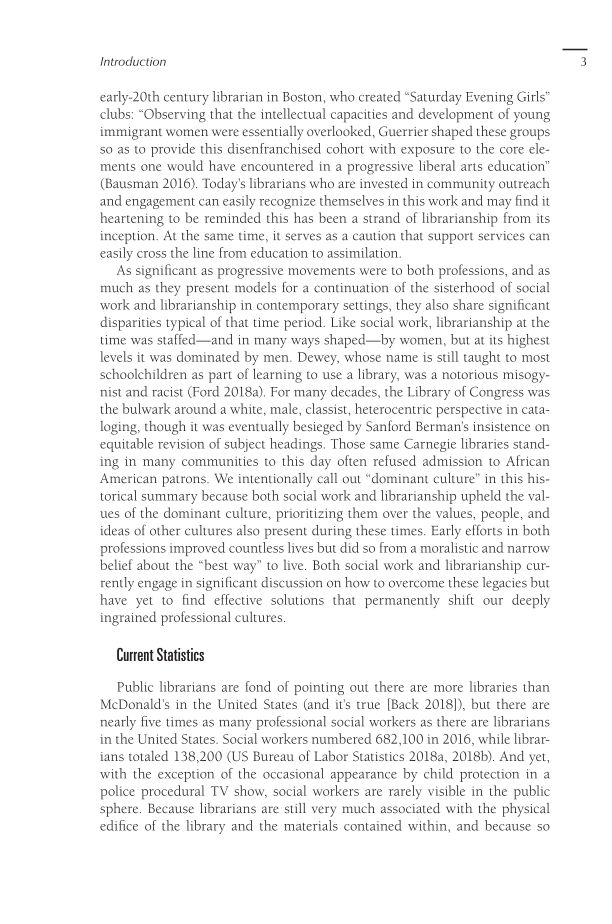Introduction 3 early-20th century librarian in Boston, who created “Saturday Evening Girls” clubs: “Observing that the intellectual capacities and development of young immigrant women were essentially overlooked, Guerrier shaped these groups so as to provide this disenfranchised cohort with exposure to the core ele- ments one would have encountered in a progressive liberal arts education” (Bausman 2016). Today’s librarians who are invested in community outreach and engagement can easily recognize themselves in this work and may find it heartening to be reminded this has been a strand of librarianship from its inception. At the same time, it serves as a caution that support services can easily cross the line from education to assimilation. As significant as progressive movements were to both professions, and as much as they present models for a continuation of the sisterhood of social work and librarianship in contemporary settings, they also share significant disparities typical of that time period. Like social work, librarianship at the time was staffed—and in many ways shaped—by women, but at its highest levels it was dominated by men. Dewey, whose name is still taught to most schoolchildren as part of learning to use a library, was a notorious misogy- nist and racist (Ford 2018a). For many decades, the Library of Congress was the bulwark around a white, male, classist, heterocentric perspective in cata- loging, though it was eventually besieged by Sanford Berman’s insistence on equitable revision of subject headings. Those same Carnegie libraries stand- ing in many communities to this day often refused admission to African American patrons. We intentionally call out “dominant culture” in this his- torical summary because both social work and librarianship upheld the val- ues of the dominant culture, prioritizing them over the values, people, and ideas of other cultures also present during these times. Early efforts in both professions improved countless lives but did so from a moralistic and narrow belief about the “best way” to live. Both social work and librarianship cur- rently engage in significant discussion on how to overcome these legacies but have yet to find effective solutions that permanently shift our deeply ingrained professional cultures. Current Statistics Public librarians are fond of pointing out there are more libraries than McDonald’s in the United States (and it’s true [Back 2018]), but there are nearly five times as many professional social workers as there are librarians in the United States. Social workers numbered 682,100 in 2016, while librar- ians totaled 138,200 (US Bureau of Labor Statistics 2018a, 2018b). And yet, with the exception of the occasional appearance by child protection in a police procedural TV show, social workers are rarely visible in the public sphere. Because librarians are still very much associated with the physical edifice of the library and the materials contained within, and because so
Document Details My Account Print multiple pages
Print
You have printed 0 times in the last 24 hours.
Your print count will reset on at .
You may print 0 more time(s) before then.
You may print a maximum of 0 pages at a time.






























































































































































































